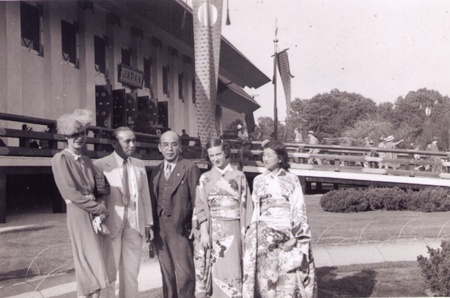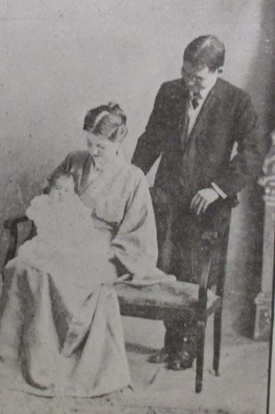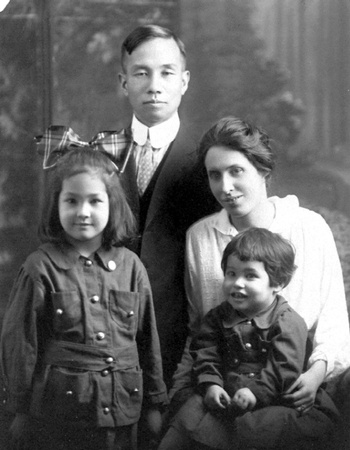In Japanese American history, Chicago is known as one of the primary urban relocation areas for those who were incarcerated in American concentration camps during World War II. The earliest wave of resettlement, composed mostly of Nisei, arrived in Chicago in June of 1942, although some “voluntary resettlers” were said to have arrived as early as March of that year.1 Since then, the relocation and resettlement history of Japanese Americans has been carefully recorded and researched by scholars, writers, and journalists. However, their discussion of the last 75 years makes it seem as if the history of the Chicago Japanese started in 1942, not many decades earlier in the late 1800s, when Japanese immigrants first came to this city.
Who Were the Chicago Nisei?
Little is known about the Nisei who were born in Chicago, particularly in the prewar years. In 1877, the first Japanese baby (i.e. the first Nisei in Chicago) was reported to have been born to two acrobats, Yae and “Professor Ganjiro.”2 Although the Illinois Censuses of 1880 and 1890 showed only Japanese who were presumably Issei sojourners3 (except for Michitaro Ongawa, who spent his whole life in the Midwest from 1871 to 1938), I found another Nisei, George Kaneko, a Chicago native born on August 2, 1886. His father was Asajiro Kaneko, and his mother was Sada, but they were not recorded in the Census as residents of Chicago.4
Lured by the World’s Columbian Exposition of 1893 (also known as the Chicago World’s Fair), many Japanese came to Chicago to look for new business opportunities. Some Issei chose to remain after the exposition and start families—as a result, more Nisei were born. In an article titled “Chicago has a Japanese New Woman,” the Chicago Tribune reported with surprise about a seven-month-old baby, Maude Seid, born to Issei parents Ding and Mandi Seid.5 Maude’s father was a tea merchant in Chicago and the article described the baby’s “very un-American appearance,” although she was “’merican” to her father. The Seids had another older Nisei boy, Richard, a nine-year-old Illinois native.6
We know quite a bit about the experiences of the West Coast Nisei: constant exposure to racial discrimination, living segregated lives in Japanese enclaves, the efforts of Issei parents to instill cultural pride in their children through Japanese language lessons. Did the Chicago Nisei have similar experiences?
Not Like West Coast Nisei
Using ancestry.com, I have been researching the Illinois Japanese population by collecting information about individuals and families from census data released between 1900 and 1940. Although few accounts of the lives of Chicago Nisei have surfaced to date, I have discovered, through my census research, several characteristics unique to the prewar Chicago Nisei—characteristics not commonly seen in Japanese communities on the West Coast. One of the most interesting was the presence of mixed-blood Nisei during the first 30 years of this period. Another was the role the Nisei played in creating a sense of ethnic community in Chicago, where the Japanese population was too small to create a significant enclave like Los Angeles’ Little Tokyo or San Francisco’s Japantown.
I attribute the presence of mixed-blood Nisei to two factors. First, single Japanese women were very scarce in Chicago in those days.7 Second, Illinois did not have miscegenation laws that prevented marriages between whites and Japanese—unlike California, which banned interracial marriages until 1948. Therefore, the early Chicago Japanese, who were not bound by the “peer pressure” of their ethnic community, were free to enter into interracial relationships.
In 1886, a newspaper article reported on interracial marriages involving Japanese. “In a year, during which the Mikado was made so popular in Chicago, it would be considered improper to avoid mention of a veritable Japanese who took out a license to wed a lady with a white skin.”8 Although we do not know who the first Japanese man to marry “a lady with a white skin” in Chicago was, we do know that adventuresome Japanese men could be found among the ranks of the travelling actors/acrobats who had been appearing in Chicago since the 1860s. Acrobat Joseph Tanaka married a white woman from Canada named Catherine around 1890 9 and was naturalized in Chicago on November 20, 1902.10 Ichiske Oshikawa, a 23-year-old performer, married a 21-year-old Austrian named Kathrine some time after 1894.11 Keneko Kinzo, an actor, married an Illinois native named Lilian around 1897.12
Mixed-blood Nisei children were born from marriages such as these. Acrobat Joseph Yoshimote was born in Chicago to acrobat parents: Japanese father Joseph and Irish mother Sadie.13 Three-year-old Elvira, a native of Illinois, was reported to be the offspring of foot jugglers George Okura and Meta (a German woman).14
According to my research, there were 74 (59 male and 15 female) Japanese living in Chicago in 1900.15 Living outside of Chicago were 11 single men, none of them engaged in agriculture, unlike in California. Out of 14 married men, four of them had white wives. Charles Bane, a 36-year-old Japanese storekeeper in Chicago, had married a German immigrant woman named Christin in Kankakee in 189416 and had two mixed-blood sons, Fred and Charles, both born in Illinois.17 In total, there were eight Nisei (five boys and three girls) under the age of 18 in 1900; three of the boys and all the girls were born in Illinois.
Attitudes Toward Interracial Marriage

How did Chicagoans look at interracial marriages between Japanese men and white women before the turn of the century? Some newspaper articles hinted at a positive attitude. For example, a Chicago Daily News reporter interviewed two white women who had Japanese husbands.18 The interviewees were Caroline, a Southern belle who was married to the famous chemist Jokichi Takamine, and Illinois native Dora, wife to Harry Kenichi Tetsuka. The Takamines and their two mixed-blood sons came to Chicago from Japan in 1890 to start a distilling business. Tetsuka, who came to the United States in 1885, was listed as having an import business, Tetsuka H.K. & Co. (185 State),19 in Chicago after the 1893 Exposition.
In the article “Love Ways of Japanese,” Caroline Takamine boasted about her husband, who she said worked hard to please her, and claimed: “Much has been written of the tyrannical husband and submissive wives of Japan, but I assure you that a Japanese wife is a very happy woman… I think Japanese make the best husbands in the world.” Chicago native Dora Tetsuka, who met her husband at the World’s Columbian Exposition and married him on January 1, 1894, was also proud of being “the first Chicago girl who ever married a Japanese,” claiming: “I know lots more (girls) who would like to (marry Japanese men) since they have known my husband.”
In a newspaper article published in Indiana, Clara Ongawa, an Iowa native who married her husband Michitaro in Austin, Illinois, in 1891, also confirmed Takamine’s claim that Japanese men make excellent husbands for American girls.20 In such an open-minded atmosphere, interracial marriages involving Japanese men, as well as births of mixed-blood children, increased steadily until the 1920s.
There were 247 Japanese (209 male and 38 female) living in Chicago in 1910, while the total number of Japanese in Illinois was 288 (249 males and 39 females).21 Exactly half of the 54 married Japanese men in the state chose wives of a different race: two had black/mulatto wives and 25 had white wives. As a consequence, out of 24 Nisei under 18 (10 boys and 14 girls),22 11 (six boys and five girls) were of mixed blood.
Among the mixed-blood Nisei were Clarke and Yuri Kawakami of Momence, Illinois. Their father was the renowned journalist, Kiyoshi Karl Kawakami, who represented the Japanese government’s views in various American newspapers and magazines after Japan’s victory over Russia in 1905. Kawakami married Mildred Clarke of Momence in 1907. Their marriage was called “a romantic wedding of international interest.”23
Sidney Tokichi Ohi, who was sent to Chicago from Japan in 1906 as a trainee to study overseas industries24 and worked for the Pullman Palace Car Company as a draftsman, married Katie Hicks, a white woman from Missouri, in 1910. One of their mixed-blood daughters, Kuma Elizabeth, born in Chicago in 1911, later became the first female Japanese American lawyer in the country. One of Kuma’s cousins, Kiyoshi Franklin Chino, was also born in Chicago in 1911 to Japanese father Haruka Frank Chino and Katie Ohi’s sister, Mercelia. Kuma and Kiyoshi were the only Japanese American students at Chicago’s John Marshall Law School in the 1930s; they went on to become two of the three Nisei lawyers working in Chicago in the prewar years. By comparison, there was only one Nisei lawyer in San Francisco, where the Japanese population was 20 times that of Chicago.25
Notes:
1. Encyclopedia of Japanese American History, updated edition, page 62.
2. Chicago Tribune, May 16, 1877.
3. The 1880 Illinois Census recorded three Japanese (two in Chicago). The 1890 Census reported 14 Japanese (none in Chicago).
4. George Kaneko birth certificate, via ancestry.com.
5. Chicago Tribune, June 7, 1896.
6. 1900 Illinois Census.
7. The 1900 Illinois Census recorded 15 females in Chicago: two married and 13 single. Eight single women were suspected to be prostitutes as they lived at 2026 Armour Avenue in the “red light” district. In July 1908, five Japanese prostitutes were arrested in this house (Chicago Tribune, July 17, 1908).
8. Chicago Tribune, January 1, 1887.
9. 1930 New York Census.
10. Certificate No. R-80 P125 Alien, Japanese American Commercial Weekly, December 6, 1902.
11. 1910 Illinois Census.
12. 1900 Illinois Census.
13. 1920 New York Census.
14. 1910 and 1920 Illinois Censuses.
15. The 1910 Illinois Census recorded 80 in total and 68 in Chicago. Author’s research found 85 Japanese in Illinois.
16. Chicago Tribune, October 11, 1894.
17. 1900 Illinois Census.
18. Chicago Daily News, November 27, 1895.
19. 1895 Chicago City Directory.
20. The Star Press, June 2, 1911.
21. The 1910 Illinois Census recorded 285 Japanese in total, with 233 living in Chicago.
22. The Chicago Tribune dated July 25, 1912, reported the results of a city school census and that “the Japanese have the smallest representation of children of any nationality in Chicago and there are only 30 children of Japanese parentage.”
23. Evansville Press, June 13, 1907.
24. Ohi was sent first to New York City in 1906 to study the iron industry but requested that the Japanese government transfer him to Chicago. 6-1-7-18 Diplomatic Archives of the Ministry of Foreign Affairs of Japan, Tokyo.
25. Greg Robinson, The Great Unknown, page 31.
© 2018 Takako Day









